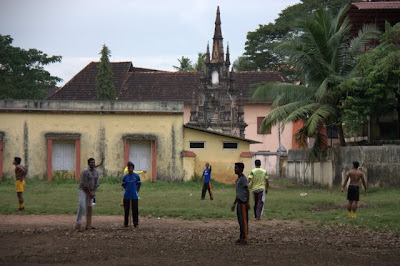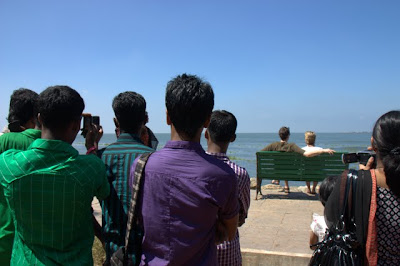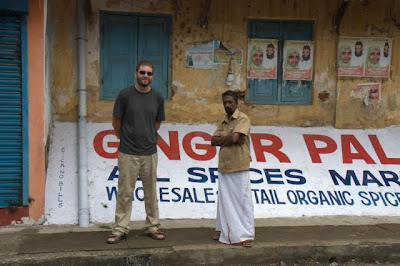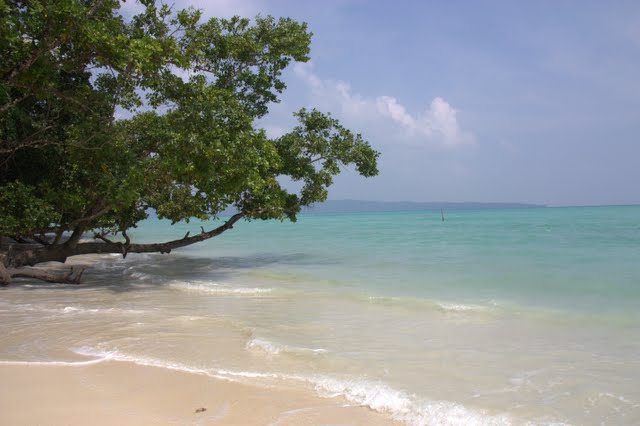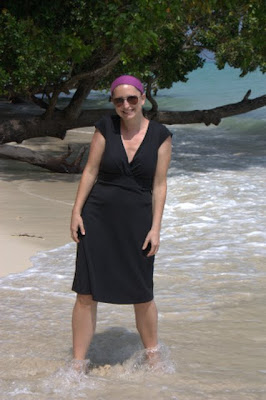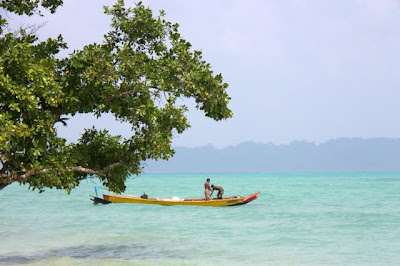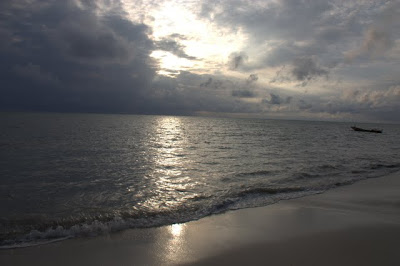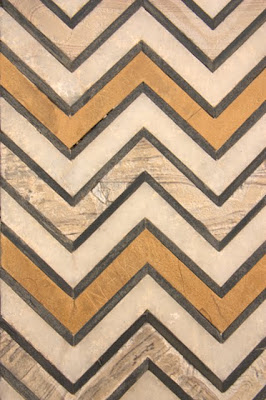12 reasons to love Bangkok and counting…
I love Bangkok. I know some people hate it. They say it is crowded, noisy, and smoggy. Maybe this is so, but coming off a month in India, Bangkok seemed positively calm, orderly and clean. Bangkok reminded me of an Asian New York City – no matter how many times you go, you can always find somewhere new to explore and something new to do. It being our first time in Bangkok, we barely scratched the surface in our week in the city, but coming up with reasons to love Bangkok was not hard. Bangkok, we’ll be back.
1. Bangkok is where you can get things DONE. We had a big to-do list in Bangkok and accomplished everything with ease. As compared to say, India, where it took us four days just to buy a train ticket out of Delhi. In a matter of days, we finished Christmas shopping for our families; shipped said presents home; bought Christmas cards featuring a monk with sunglasses and who-knows-what sort of message in Thai; bought new shorts for Sean and a new dress for me; got Sean’s hairs cut; replenished our toiletries; bought guidebooks (at a discount, of course) for our southeast Asian travels; and got my camera cleaned at an official Canon center in the MBK mall for a fraction of what it would cost at home.
2. Bangkok is modern. Although other cities in southeast Asia can fool you into thinking they are modernized and sleek, eventually something crazy happens to make you remember that you are in the middle of an area that operates with inefficiencies, corruptions, crazy rigged vehicles and squat toilets. Not that this description couldn’t be applied to Thailand, but for the most part, Bangkok can hold its own better than its regional neighbors against other world-class international metropolises. There’s something comforting about knowing that no matter where you are in southeast Asia, as long as you get back to Bangkok you can accomplish tasks (see number one), experience modern conveniences you can’t find elsewhere, and obtain healthcare if needed on par with what you would receive at home.
3. Bangkok has movies galore. Nothing erases homesickness quite like watching a Hollywood film in the theater. Although we’ve tried to catch good movies on the road before, our timing was never quite right. In Bangkok, however, we had our choice of films from a plethora of theaters, prompting us to go twice in one week. (We saw Eat, Pray, Love and the Pittsburgh-based Next Three Days, if you are wondering. We also caught the Social Network for $2 the following week in Chiang Mai). Just like home, movies in Thailand come complete with giant popcorns and Cokes. Quite unlike home, movies are cheap (about $4), seats are assigned, and everyone gives a standing ovation to the King before the movie starts.
4. Bangkok has cheap, tasty street food… From our favorite pad thai in Thailand for under a dollar, to stir-fries galore, to fresh fruit stands, to fried pancakes with bananas and Skippy peanut butter, to mango and sticky rice, Bangkok is yummy.
5. …and Bangkok has street laundry. We paid way too much at our guesthouse for our first load of laundry before we discovered the coin washing machines randomly stuck outside shops and homes. Awesome.
6. Bangkok has fabulous, cheap massages. $4 neck-and-shoulder massages. Need I say more?
7. Bangkok is shiny and pretty. Whether illuminated by sunshine or street lamps, the wats in Bangkok positively shimmer.
8. Bangkok has a BIG Buddha. I’ve decided that I like my Buddhas big. The bigger, the better, and Bangkok has one of the biggest in Thailand. The reclining Buddha at Wat Pho is HUGE. I was memorized by his giant marble-inlay feet, relaxed posture, and melodic pings of coins hitting metal as Buddhist devotees circled the room.
9. Bangkok has nooks and crannies. While dodging the zany traffic on Bangkok’s main streets and street vendors on the sidewalks can drive you bonkers, the sois (side streets) are quiet and peaceful. You’ll find families living in their shops, children playing in the streets, budding guitarists, tropical flowers, tailless kitties, and you-never-know-what-else in the sois.
10. Bangkok has shopping. From everything under the sun at the enormous Saturday market, to cheap knock-offs on the street, to fancy stores at the malls on Silom Road, to up and coming designers in Little Siam, you can shop until you drop in Bangkok.
11. Bangkok has waterways. I loved discovering random canals lined with tropical greenery tucked between streets, and loved even more that Thais put their rivers to good use by running water taxis up and down to avoid the congested streets.
12. Bangkok has flowers. If there is one thing that makes me happy, it’s colorful flowers, and Bangkok’s nightly market, Pak Khlong Talat, has them in abundance. Strolling through the market, surrounded by tropical flowers on all sides, made me feel like I was in a kaleidescope. The market was hands down my favorite part of Bangkok. I loved Pak Khlong Talat so much, I’m saving my photos from the market for its own post.
Backwaters
And when I wake up in the morning to feel the daybreak on my face. There’s a blood that’s flowin’ through the feeling, with a knife to open up the sky’s veins. Some things will never change. They stand there looking backwards half unconscious from the pain. They may seem rearranged. In the backwater swirling, there is something that will never change.
– Backwater, Meat Puppets
Old black water, keep on rollin’
Mississippi moon, won’t you keep on shinin’ on me
Old black water, keep on rollin’
Mississippi moon, won’t you keep on shinin’ on me
Old black water, keep on rollin’
Mississippi moon, won’t you keep on shinin’ on me
Yeah, keep on shinin’ your light
Gonna make everything, pretty mama
Gonna make everything all right
And I ain’t got no worries
‘Cause I ain’t in no hurry at all
– Black Water, Doobie Brothers
The real jewel of God’s Country is undoubtedly Kerala’s backwaters. (Hence the busting out of an old 90s tune; the running soundtrack in my brain while we were in this part of Kerala was either this Meat Puppets song or Black Water. The waters weren’t black, but close enough.) Laying parallel to the Arabian Sea, the Keralan backwaters are a network of interconnected canals, rivers, lakes and inlets stretching for over 900 km. The canals are like roads; many people’s houses can only be accessed by boat and road signs give the distance to the next village. Similar to the Ganges, people who live along the backwaters very much live their lives in public, using the backwaters to bathe, wash dishes, and launder clothes. We did as many visitors to the backwaters do: rent an overnight houseboat to explore the labyrinth of canals and lakes. The houseboat comes with a two man boat crew, and you get three Keralean meals cooked aboard by one of the crew. Our experience on the backwaters was mixed: seeing life on the backwaters was fascinating, the scenery divine, but taking a tour by day probably would have accomplished the same thing for less money and maybe even allowed us to have seen more side canals. On the other hand, we did get to kick back and relax, and see the sun set over the backwaters. I took the picture above as we docked for the night next to one of the crew member’s canal side house.
Our biggest concern turned out to be our drinking water. When you read in the guidebook to always check to make sure your water bottles in India are sealed, do it. During negotiations for the boat ride, the owner promised us that the price included lots of bottles of water for us to drink. After getting out on the backwaters, Sean asked the crew for some water. One of them took a water bottle from the cooler, opened it, and handed it to Sean. After we finished the first bottle, we asked for a second one. This time, I happened to open the bottle myself, and noticed the cap wasn’t attached. I asked the other crew member for a different bottle. The new bottle also had a cap that wasn’t attached, and I inquired him why. Eventually, through a conversation in halting English, we established that all of the bottles weren’t factory sealed, they refill bottles of water themselves, and Sean and I weren’t happy about this situation, especially since we unknowingly drank one bottle already. If there’s one thing you don’t want to do in India, it is to drink the water. It was never clear to us whether this was a practice directed by the owner or whether the crew did it themselves. It appeared that the owner gave the crew money to purchase food and supplies for the trip, and we suspected that the crew may have been refilling water bottles themselves to try to save a few rupees. As it turns out, the crew picked us up a case of factory-sealed drinking water (which may not have been much of an improvement, as it was some sketchy brand we hadn’t seen elsewhere called Pizza Water with tons of misspellings on the container), and we never got sick from drinking whatever type of water with which they had refilled the original bottles. It is this type of thing that frustrates you again and again in India. No one means any harm, but you can never let your guard down.
Welcome to God’s Country
We’d heard time and time again that southern India is much more laid back than northern India. As we landed in the southern Indian state of Kerala, we were hesitant. Having just left the blissful Andaman Islands, we weren’t really in the mood to dive back into the madness we had experienced in the north.
We can’t speak for all of southern India, but take it from us, Kerala is definitely not the north. On the way to our guesthouse from the airport, we were very confused. Why was the cars driving in their own lanes? Why weren’t they cutting off other cars? And most importantly, why is no one honking?
The state of Kerala is actually the world’s only democratically elected communist government and is one of India’s most progressive states. We hear that its not all rosy in Kerala – many breadwinners have to live abroad in the UAE and send money home to their families in order to make ends meet – but Kerala has made great strides in things like improving health care, raising literacy rates, and reducing litter. Keralans are proud of their state and have deemed it to be “God’s Own Country.”
A higher power certainly has bestowed beauty and lush tropical greenness upon Kerala. Our first introduction to Kerala was in the town of Fort Cochin, which is in the running with Kolkata to be my favorite city in India. (Not counting the fabulous Andaman Islands, of course). Like Kolkata, you can tell that the British once made their presence known in Fort Cochin. The Dutch and Portuguese also made their mark. Fort Cochin has a big Christian presence, and it was there that I saw an Indian nun for the first (and only) time.
Once we eliminated the small problem of ants trying to take up residence in our backpacks, we kept adding days onto our stay in Fort Cochin. We kept finding reasons to dawdle: an adorable little teahouse with Indian teas and a respectable death by chocolate cake; movie shoots to try to work our way into as extras; tropical flowers to photograph; fresh Keralean pineapple; waterside boardwalks with headbutting goats, Chinese fishing nets, ancient sprawling trees, and 1 rupee scales that tell you about your weight loss; Sean’s new Indian friends George and Justin at the old-school internet cafe; a cooking class to learn more about Keralean cuisine; an aryvuedic massage (which actually turned out to be NOT a good idea, but more on that later); dinner at a trendy, modern cafe cooked by local women; simultaneous pickup cricket and soccer games to watch; fantastic, delicious prawns from the seafood market, cooked with ginger and garlic; rickshaws decorated like Ferraris; real chicken briyani, finally; and tours by a guide named Magic Johnson. (And yes, I know there’s a lot of food on that list – we had some of our best meals in India in Fort Cochin).
Fort Cochin was enchanting, and we could have stayed longer, but the backwaters and beaches in God’s country were calling…
The one in which you will hate us if you are reading this from work or from a cold locale…
To say we were in India for 31 days almost feels like we were cheating, because 13 of those days were on the Andaman and Nicobar Islands. Set in the Bay of Bengal between India and Thailand, the islands are technically part of India, but their remoteness makes them something unique. The islands are actually geographically closer to Burma/Mynamar and Thailand than they are to India, but as of now, they can only be reached from India’s mainland. Because of their relative inaccessibility, development on the islands has been slow. Most of the tourists on the Andamans are upper-class Indians. Foreign tourists and most local tourists are not allowed to enter the Nicobar Islands, where ethnic tribes have been living their lives undisturbed for hundreds of years. Luckily for us, tourists are allowed , with a permit, onto the Andaman Islands. Other than a brief stint in Port Blair, the port of entry, we stayed at the Emerald Gecko on Havelock Island in a hut that was $15 a night. Beach No. 5, above, was a few feet from our doorstep. The Andamans are best seen, not described, so here’s some photos to either get you throwing darts at our pictures or, better yet, encouraging you to put New Year’s travel resolutions into action:
Port Blair:
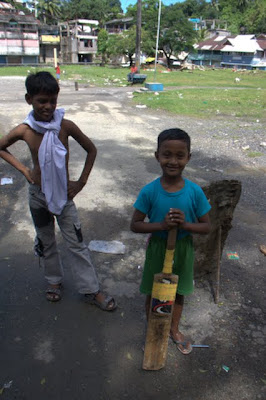
To reach the islands, all visitors must fly onto the main island at Port Blair. Contrary to what Lonely Planet may try to tell you, Port Blair is a get in and get out type of place. It's not what you've came all this way to see, but you at least have to spend the night on your way out of the Andamans. We spent most of our time on Port Blair making use of the glacially slow internet, but we wandered around a bit. We came across these kids playing cricket in an empty lot, who paused their game to eagerly jump in front of the camera.

While the food on Havelock Island (and particularly at the Emerald Gecko) was some of the best we've had on our trip, the food in Port Blair leaves a lot to be desired. I ordered naan, an Indian bread, and it was served to me like this: wrapped in a dish towel that looked like it was used to clean up the kitchen for the post month. To add insult to injury, the waiter kept urging me to eat it, and even went as far as to unwrap it and touch the naan, saying, "why don't you eat the naan? It is hot, see? You must eat it when it is hot." I developed a sudden bread allergy...
Beach No. 5, Havelock Island

Upon our arrival on Havelock, we promptly took naps in these hammocks, listening to the waves. Sean thus achieved a goal he first had formulated when sitting in his cube. We could often be found here during our 10 days on the island. We nicknamed another couple the Hammock Hogs because they were often occupying the hammocks when we wanted to use them, but given the amount of time we spent there, I think the nickname was more appropriate for us.
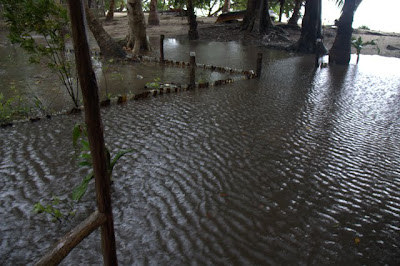
The flip side to the lushness of paradise is that it must rain. We accidentally went to the Andamans during monsoon season, which meant we were subjected to two days of torrential downpours. The rains flooded the grounds of Emerald Gecko. This was the view from our hut during the rains.
The Infamous Beach No. 7

If you spend any amount of time on Havelock, you will soon hear about the lure of Beach No. 7, located way on the other side of the island. All of Havelock's beaches have white sand and waters that are different shades of blue and green, but none of the beaches have sand as soft as or waters that are as clear and easy to swim in as Beach No. 7.
Around the rest of Havelock Island

When we weren't napping in hammocks or lounging on beaches, you might find us scooting around the island on the scooter we rented for $4 a day.

Sean at Anju Coco, a shacklike restaurant we frequented when we weren't scarfing down the delicious food at Emerald Gecko. Despite eating banana pancakes for 10 days straight, I never got a photo.

One of our favorite days on the island was when we took the scooter past Beach No. 5 away from Village No. 1. There is a small, but developing tourist strip from Beach No. 3 to Beach No. 5, but beyond, there was not a tourist in sight. (Yes, everything is known by numbers, not names).

It is not hard to find fantastic deserted beaches around the island, especially if you head past Beach No. 5 away from the boat jetty in Village No. 1.
The Taj Mahal of Agra
I’m not sure why we bothered to visit the Taj Mahal, really. Considering we used to live in a building so similar. Or at least that’s what our old landlord told us. Before we were married, we rented a 2-story duplex in Etna. On the phone when I was setting up an appointment to view the duplex, the landlord told me, You’ll definitely recognize the building. It is the big one on left side of the street. It is so grand that some people call it the Taj Mahal of Etna.
I definitely see the resemblance. Don’t you?
The Taj Mahal of Agra, on the other hand, is really a spectacular building. It gleams, especially in the early morning light in the couple of hours after sunrise. I’m a sucker for symmetry. It’s what I fell in love with on our first house (not the rental) and it’s what I fell in love with on the Taj. I knew the Taj Mahal would be beautiful from afar; I didn’t realize that it would also be so beautiful up close. Its elegance astounded me.
The true test of how amazing the Taj Mahal was its ability to lull us out of our cranky moods. The night before we visited, we went to bed at a decent hour because we planned to get up at sunrise. India had other plans for us. There was some sort of festival going on – always a festival – that involved tinny, haunting music blasting out of a loudspeaker. A loudspeaker that was directly outside our room. A loudspeaker that, true to its name, was so loud that we could still hear it even when we played music through our noise-isolating headphones. The only way to drown it out was to play the most raucous rock’n’roll we had on top volume. Periodically the festival music would die down. Once we realized, we’d turn off our Ipods and settle in for some sleep, finally. Then, chanting would begin, followed by music even louder than before. This special brand of torture didn’t end until 3:30 in the morning – two hours before sunrise. It is a good thing the Taj Mahal of Agra didn’t look a thing like the Taj Mahal of Etna.












